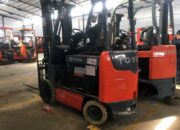Forklift Operational Costs and Optimization Strategies
Mechanical forklifts are indispensable equipment in industries, warehousing, logistics, and manufacturing sectors, significantly enhancing labor productivity. However, alongside their substantial benefits, forklift ownership and operation also entail considerable expenses. Understanding and effectively controlling these costs is the key to optimizing business operations.
This analysis will provide a detailed examination of forklift operational costs, influencing factors, and effective optimization solutions.
Comprehensive Analysis of Forklift Operational Costs
To gain a holistic perspective, we will analyze forklift operational costs throughout its lifecycle, from initial purchase to eventual disposal.
- Initial Forklift Investment Costs
These are the immediate expenses incurred when deciding to invest in a forklift, including:
Purchase Price: The most significant price determinant includes the brand, load capacity, engine type, and accompanying features.
Japanese brand forklifts (Toyota, Komatsu, etc.) typically command higher prices compared to Chinese or Korean manufacturers.
Forklifts with higher load capacities, powerful engines, and advanced features (such as safety systems, enclosed cabins) will have elevated price points.
Transportation and Installation Costs: These vary depending on transportation distance and installation complexity.
Staff Training Expenses: Systematic training for operators is essential to ensure workplace safety, efficient operation, and extended forklift longevity.
- Forklift Fuel Consumption Costs
Internal Combustion Engine Forklifts: Fuel costs (gasoline, diesel) represent a significant proportion of operational expenses. Fuel consumption depends on the vehicle type, engine power, operational intensity, and operator skills.
Electric Forklifts: Primarily powered by electrical energy. Costs are influenced by electricity prices, vehicle power, and charging duration.
- Maintenance and Repair Costs
Scheduled Maintenance: A mandatory activity ensuring stable operation and extended equipment life. Periodic maintenance includes oil changes, air filters, oil filters, brake system checks, and hydraulic system inspections.
Repairs: Incurred when forklifts experience mechanical failures. Repair costs depend on damage severity, replacement part prices, and labor expenses.
- Operational Labor Costs
Operator Wages and Benefits: These costs are contingent on market average wages and the company’s compensation policies.
Management and Supervision Expenses: Including costs for management teams overseeing forklift operations and personnel.
- Ancillary Forklift-Related Costs
External Rental Expenses: When internal forklifts are insufficient or usage peaks, companies may rent additional equipment from service providers.
Operational Downtime Costs: Equipment failures can interrupt production and business processes, causing time and productivity losses.
Asset Depreciation: Forklifts are fixed assets subject to depreciation over their operational lifecycle.
Key Factors Influencing Forklift Operational Costs
Operational Intensity: High-frequency, long-duration operations increase fuel consumption, accelerate component wear, and elevate maintenance and repair expenses.
Working Environment: Challenging environments (high temperatures, dust, high humidity) impact operational efficiency and equipment longevity, increasing maintenance costs.
Forklift Type: Different forklift types (diesel, electric, gas) exhibit varying fuel consumption and maintenance expenses.
Maintenance Quality: Periodic, technically-sound maintenance ensures stable operation, extends equipment life, and minimizes repair costs.
Operational Skills: Professionally trained operators enhance safety, operational efficiency, fuel conservation, and minimize equipment damage.
Strategies for Optimizing Forklift Operational Costs
- Selecting Appropriate Forklift Equipment
Determine Usage Requirements: Clearly define lifting capacity, work environment (indoor/outdoor), and operational intensity to select suitable equipment.
Compare Forklift Models and Brands: Thoroughly research technical specifications, features, pricing, and warranty conditions before making decisions.
Consider Long-Term Investment and Operational Costs: Focus not just on initial purchase price but calculate comprehensive lifecycle operational expenses.
- Implement Robust Scheduled Maintenance
Adhere to Manufacturer Maintenance Schedules: Comprehensively execute all recommended maintenance items.
Use Genuine Replacement Parts: Prioritize original manufacturer parts to maintain quality and extend equipment life.
Select Reputable Maintenance Providers: Experienced, skilled service providers can detect and address issues promptly, ensuring stable equipment operation.
- Emphasize Operator Training and Skill Development
Provide Comprehensive Operator Training: Equip personnel with knowledge about equipment structure, operational principles, and safe, efficient operating techniques.
Promote Safe and Fuel-Efficient Operation: Implement workplace safety protocols and proper operational techniques to minimize fuel wastage.
- Implement Scientific and Efficient Management
Track and Document Operational Expenses: Maintain comprehensive records of all incurred costs (fuel, maintenance, repairs) for monitoring and control.
Conduct Periodic Analysis and Optimization: Regularly analyze cost data to assess operational efficiency and develop improvement strategies.
Leverage Technology in Management: Utilize forklift management software and tracking devices to monitor operations, control expenses, and enhance management effectiveness.







